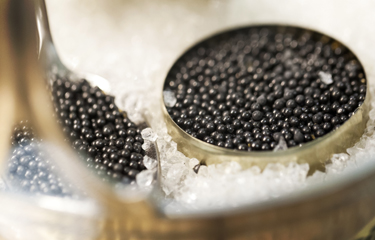The latest report on the caviar market from the European Market Observatory for Fisheries and Aquaculture Products (EUMOFA) shows that in 2018, global aquaculture production of sturgeon was around 115,000 metric tons (MT), and production of caviar was 380 MT.
China accounted for 84 percent of global sturgeon production with 97,000 MT, followed by Armenia at 3 percent, or 3,900 MT; and Russia at 3 percent, or3,800 MT. Much of China’s sturgeon production is destined for consumption, but the country also supplies around one third of the global caviar volume, and is the main supplier to the E.U.
The U.S. produced 1,166 MT of sturgeon and 18 MT of caviar in 2018, exporting 39 percent to Japan, 27 percent to Canada, and 22 percent to the E.U. The price of American caviar exports dropped from EUR 303 (USD 367) per kilogram in 2014 to EUR 188 (USD 228) per kilogram in 2020.
European countries produced 164 MT of caviar, with Italy, France, Poland, and Germany accounting for 84 percent of the total. The yearly weighted average extra-E.U. export prices over the past seven years range from EUR 422 (USD 511) per kilogram to EUR 538 (USD 652) per kilogram and are, on average, 17 percent higher than intra-E.U. export prices and 54 percent higher than extra-E.U. import prices.
EUMOFA estimates that total E.U. apparent consumption of caviar in 2018 was between 121 MT and 126 MT, and that E.U. production of caviar increased by 30 percent over 2016 totals. Meanwhile, apparent consumption in the E.U. increased by 20 percent.
In the E.U., France has the highest apparent consumption at 57.9 tons, followed by Germany (25.7 tons) and Spain (9.3 tons). Other main caviar consuming countries are the U.S., Japan, Russia, China, Canada, Switzerland, the U.K., the United Arab Emirates, Singapore, and Australia.
Virtually all caviar on the market today comes from farmed sturgeon, and wild capture of this fish fell from a high of 31,800 MT in 1977 to just 222 MT recorded in 2018. Overfishing of sturgeon has led to near-extinction of several species, and since 1998, international trade in sturgeon and related products is regulated under the Convention on International Trade in Endangered Species of Wild Fauna and Flora (CITES), which classes sturgeons among the world's most valuable wildlife resources.
The grade and price of caviar is determined by a number of factors, including pearl size, texture, colour, lucidity, uniformity, separation, fragrance, firmness, taste, and maturity.
The most highly-prized caviar is beluga, which comes from the beluga sturgeon (Huso huso), followed by osetra from the Danube sturgeon (Acipenser gueldenstaedtii), and sevruga from the starry sturgeon (Acipenser stellatus). However, most farmed caviar found on the market comes from the white sturgeon (Acipenser transmontanus), or the shortnose sturgeon (Acipenser brevirostrum) with more coveted caviar originating from the Siberian sturgeon (Acipenser baerii) and the beluga-like kaluga sturgeon (Huso dauricus).
The EUMOFA report points out that caviar’s scarcity and high price make it most popular in high-end markets such as Michelin-starred restaurants and high-end hotels, specialist retail shops, and the higher-fare segments of airlines and cruise ships.
It also points out that the COVID-19 pandemic had a strong impact on traditional caviar trade throughout 2020, but many producers reported increased sales through their websites and retail, and some restaurants switched to ordering small tins to accompany take-away meals. In France, caviar producers took to the media to promote their products and raise awareness of foreign competition, encouraging consumers to purchase domestic caviar.
Photo courtesy of Evannovostro/Shutterstock







